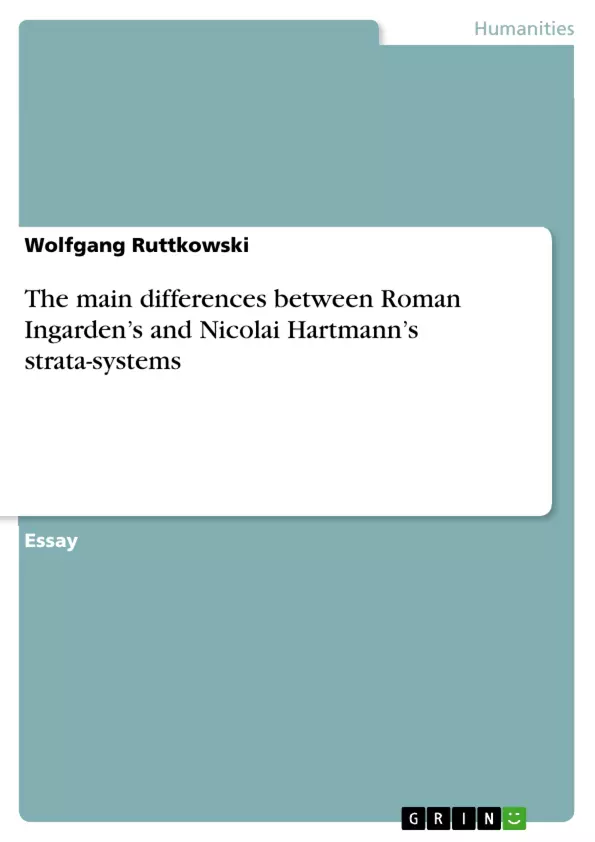Although both designed strata models for various kinds of art and especially for literature, the philosophers Nicolai Hartmann and Roman Ingarden never entered into any kind of dialogue. Also in secondary literature there is no exact comparison of their systems to be found.
For that reason, the two strata systems are compared here for the first time and their resp. advantages and deficiencies are being pointed out.
Amongst other things, the following topics are being discussed: 1. In what way Hartmann's "Real Foreground" ("Realer Vordergrund") is more specifically subdivided in Ingarden's system, 2. How, on the other hand, Ingarden's "Stratum of Depicted Objects" ("Schicht der dargestellten Gegenständlichkeiten") was more thoroughly subdivided by Hartmann, 3. Why there cannot be found in Hartmann's system a corresponding stratum for Ingarden's "Stratum of Schematized Aspects" ("Schicht der schematischen Ansichten") and 4. Why Hartmann's two strata of the "Irreal Background" ("Irrealer Hintergrund") are consolidated by Ingarden and expressly not seen as a stratum.
(In: Acta Humanistica XIX/3, Foreign Lang. and Lit. S. No. 17,June 1990, 64-82)
Inhaltsverzeichnis (Table of Contents)
- The Main Differences Between Roman Ingarden's and Nicolai Hartmann's Strata-Systems
- The Stratification of the Literary Work of Art according to Roman Ingarden (1931/1968)
- The Stratification of the Literary Work of Art according to Nicolai Hartmann (1933/1953)
Zielsetzung und Themenschwerpunkte (Objectives and Key Themes)
This article compares the strata-models of Roman Ingarden and Nicolai Hartmann, two philosophers who developed models for analyzing various art forms, particularly literature. Despite their contemporary work, the authors engaged in limited dialogue, and there is no in-depth comparison of their systems in secondary literature. The article aims to bridge this gap by presenting a detailed analysis of the differences between Ingarden's and Hartmann's models.
- Comparison of the strata-models and identification of their respective strengths and weaknesses.
- Analysis of the subdivisions within the "Real Foreground" in Hartmann's model and its corresponding strata in Ingarden's system.
- Examination of the differences in the subdivision of Ingarden's "Stratum of Depicted Objects" within Hartmann's model.
- Exploration of the absence of an equivalent stratum for Ingarden's "Stratum of Schematized Aspects" in Hartmann's system.
- Discussion of the consolidation of Hartmann's "Irreal Background" strata into a single stratum in Ingarden's system.
Zusammenfassung der Kapitel (Chapter Summaries)
This article focuses on the differences between the strata-models of Ingarden and Hartmann, specifically examining four points of divergence. The first section compares the two models and their respective strata, providing a visual representation of their structures. The second section delves into the differences regarding the "Real Foreground" and its subdivisions within Ingarden's system. The third section analyzes the contrasting treatments of the "Stratum of Depicted Objects," highlighting the more comprehensive subdivision offered by Hartmann. The fourth section explores the absence of a corresponding stratum for Ingarden's "Stratum of Schematized Aspects" in Hartmann's system. Finally, the fifth section examines the consolidation of Hartmann's "Irreal Background" strata in Ingarden's model.
Schlüsselwörter (Keywords)
This article focuses on the strata-models of Roman Ingarden and Nicolai Hartmann, examining the key differences between their approaches to analyzing the structure of literary works. It utilizes key terms such as "real foreground," "irreal background," "strata," "depicted objects," "schematized aspects," and "metaphysical qualities" to explore the various levels of abstraction within literary art. This analysis is intended to provide a deeper understanding of the different ways in which these two influential philosophers conceptualized the structure of artistic creation.
- Quote paper
- Dr. Wolfgang Ruttkowski (Author), 1990, The main differences between Roman Ingarden’s and Nicolai Hartmann’s strata-systems, Munich, GRIN Verlag, https://www.grin.com/document/81090



